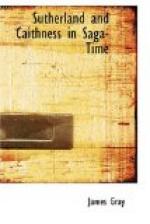Bishop Gilbert had also translated the Psalms into Gaelic; and, having set his diocese of Caithness, comprising the modern counties of Sutherland and Caithness, in good working order, and having re-buried his predecessor Adam, with a stately funeral, at Dornoch in 1239, had made his will in 1242, and died in the episcopal palace at Scrabster, near Thurso, in 1245. It was probably during his episcopate that King Alexander II gave his open letter,[7] directed to the sheriffs, bailies, and other good men of Moray and Caithness, and enjoining them to protect the ship of the Abbot and Convent of Scone and their men and goods from injury, molestation or damage in their journeys to the north. Bishop Gilbert was buried at Dornoch, and was succeeded by Bishop William,[8] and he in his turn, in 1261, by Bishop Walter de Baltroddi, who doubtless suffered from King Hakon’s fines levied in Caithness in 1263, and whose daughter the Chief of the Mackays is said to have married after that date.
In 1261 the Hebrides had been harried by William, MacFerchar, Earl of Ross and uncle of Freskin de Moravia the younger, with great cruelty and barbarity, and King Hakon in 1263 began to collect and equip a fleet with a view to revenging the injury done to his subjects in the west.[9] In the preparation for this in the spring of 1263, we find Jon Langlifson, whose mother Langlif was Harold Maddadson’s youngest daughter, and who was thus himself a nephew of Earl John, sent over with Henry Skot to Shetland to obtain pilots for King Hakon,[10] while Dougal of the Isles met them in Orkney, and was let into the secret of Hakon’s intended expedition.
Meantime Earl Magnus II, being, according to our conjectures, a member of the Angus line, whose mother was an elder sister of Harald Ungi, and being also the husband of Earl John’s daughter, had become entitled to the earldom of Orkney soon after Earl John’s death in 1231, and probably since 1236 had held part of Caithness as Earl, by heirship, and by charter from the Scottish King. Magnus II, soon after the earldom of Sutherland had been taken away from him, had died in 1239. Gillebride had then succeeded to both the reduced Scottish earldom of Caithness and the whole of the Orkney jarldom as successor in the Angus line of Magnus II; and Gillebride had died in 1256 leaving a son Magnus III. Like his predecessors, Magnus III seems to have found himself in the awkward




